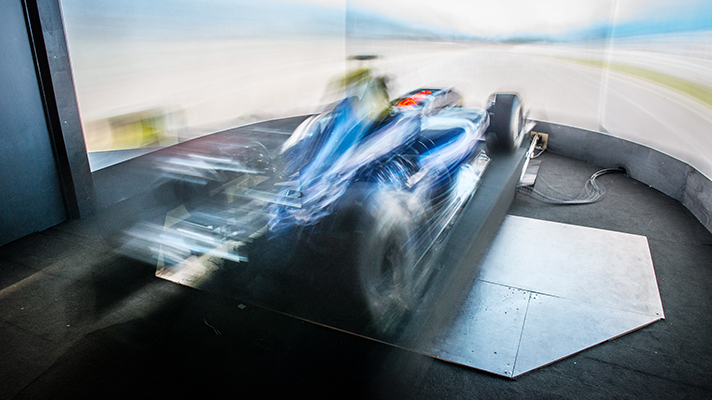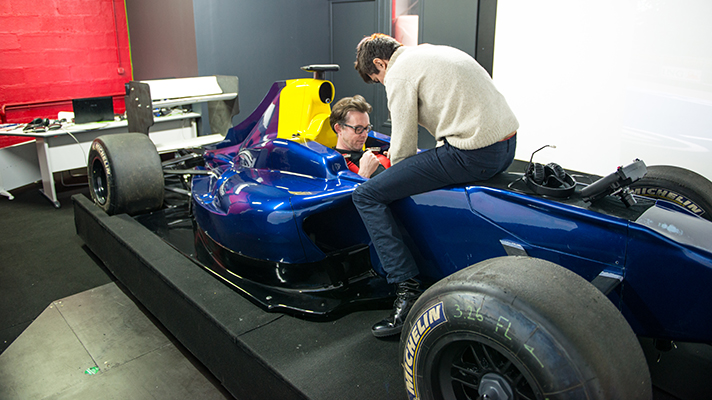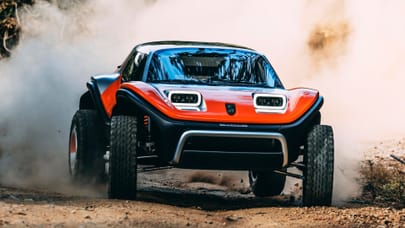
Top Gear tests the £120,000 driving game
Julien Abelli is the 25-year old stunt driver for the excellent French cop drama Spiral. He's also quite handy behind the wheel of a racing car: he went up against Nico Hulkenberg and Sebastien Buemi in junior karting, and finished fourth in a Formula Renault series.
An able helmsman, then. A smart one, too. When the cost of his burgeoning motorsport career became prohibitive, he decided to cut costs and build his own racing simulator to practice. He then foolishly invited TG to come and test it.
The super-sim no longer lives in in Abelli's bedroom, but a warehouse on a light-industrial estate just outside Paris. This is no lashed-together chair-and-steering-wheel-and-ironing-board set-up either. The ‘facility' is like walking in to Richie Rich's games room. In the middle sits a full-size, fibreglass replica of Sebastien Vettel's RB6. It had been made by hand, following nothing more than a Haynes manual and a couple of blueprints from the internet.
The RB6 sits atop a bed of hydraulics, digitally parked in one of Spa-Francorchamps's pit garages thanks to a massive 11.5-metre wide, two-metre tall projection of the cockpit on a wraparound screen.
It's the result of a five-year build, countless hours reading simulator forums online and a Matrix-trilogy worth of computer coding - all done by Julien. On his own.
It started life as a static rig in his bedroom, then morphed to a two-axis sim. Then, after Abelli studied McLaren's in-house F1 simulator, his effort swelled to such a size that it now lives full-time in a warehouse.
It's hydraulically powered, has pitch, roll, yaw and heave incorporated, and makes returning to using a normal controller for your racing games completely impossible.
TopGear.com is not completely new to advanced simulators, having experienced the sextuplet of "consoles" at iWay in Lyon. We thought they were impressive, but this is on another level.
"iWay's simulators are heavy," Julien says of his local competition. "They're also electric movement, rather than hydraulic, so can't make the G-forces easily as they can't react quick enough."
Heading out on the digital track isn't as easy as wiping down your Cheeto-greased palms and picking up a controller. First you have to climb over the fiberglass sidepod, then wiggle your way into the tight cockpit. And then someone has to pin you to the chassis with the same six-point seatbelts Sebastian Vettel uses on race day.
After all this, you have to work out the wheel. It's a replica of a proper F1 wheel, with a Skittles grab-bag of buttons glued to it. Every one works, including DRS, KERS and radio to the pitwall. If you struggle with the complexity of a PlayStation or Xbox controller, this thing will give you an aneurism.
Pulling out of the pits, I test the vital controls to get a feel for the car, starting with the brakes. First mistake. The pedals are weighted the same as a GP2 car: so the brake pedal is solid, and the accelerator is light with a lot of travel. But what I wasn't told was that the seatbelts have four pre-tensioners to squeeze you to mimic the feel of braking. It adds instant excitement, but also a great deal of pain. Particularly in the downstairs region.
A pit stop of adjustment later, I try the accelerator. There's no traction control or ABS (we're running a 2013 F1 setup without KERS or DRS, as thinking of three things at once is frankly too much for my meagre intellect). Even with a progressive push of the pedal to avoid a mass of wheel spin, the whole car feels like it's reeling back onto its hind legs as the seatbelts tighten. A computer trick it may be, but it feels very visceral and fast.
While it can't recreate the lengthy build-up of g's you'd experience through, say, a long, fast corner on a racetrack, Julien's sim replicates the sensation with a short but intense g-force experience. It pumps out a maximum of 2.5g for 0.3 seconds under acceleration and braking. That's a whole g more than iWay's simulators can produce, but still highlights the limitations of a sim in subjecting drivers to the physical strains of driving a racetrack.
Even so, the rig throws the chassis in every fathomable direction, clanking and hissing as it goes. It shifts up to a metre forwards and backwards during acceleration and deceleration, swings left and right up to five metres during cornering, and hops up and down by 15cm to shake your lunch from your stomach as you hop over the kerbs.
When playing a game with a controller, the myriad of sensations a car produces has to be portrayed through a couple of triggers, sticks and rumble packs. In the simulator these are individually isolated.
If the car steps out of line, you feel this initially through your backside and then through the wheel trying fight you, just like you would in the real thing. Your brain tells your arms to respond by applying opposite lock and your feet to back off the throttle to collect the slide. At least, it does after the fourth spin.
Visually, the experience is far from stunning: the simulator runs off a 2007 version of rFactor (it's open-source and offers a vast amount of dynamic detail for the cars). But after a couple of minutes of playing, your eyes smooth over the awkward pixels as you become hooked into the driving experience.
Swapping from an F1 car and a Porsche 911 GT car, the difference in weight distribution and general car balance is also clear. And boy, it's addictive. You become a racing driver, stepping out of the car and checking your telemetry traces to see where to trim tenths off your time, and making whiny, unconvincing excuses for where you've gone wrong.
Julien wants to make a business out of virtual reality. He's launching a company called I-S.IM, which is set to launch at the start of next year.
The plan is to build ten simulators and place them in cities so you can pop down, strap in and receive training from professional racing drivers, for around £120 an hour. They're even making it compatible with Occulus Rift virtual reality goggles, so you'll look like a steampunk scuba diver behind the wheel, but will have even more engrossing and possibly even more sicky experience.
After half a day of getting beaten up (trust us, crashing hurts) and sweating it out in the simulator, we managed to get within six seconds of Jenson Button's qualifying pace in his McLaren at Spa.
We've never enjoyed a driving game so much. And although the system maybe visually limited, it's as close as us mortals will get to driving an F1 car round Spa. And if you've got £120,000 to spare, Julien will build you one. If he can find time between nailing J-turns in French cop dramas...
Top Gear
Newsletter
Thank you for subscribing to our newsletter. Look out for your regular round-up of news, reviews and offers in your inbox.
Get all the latest news, reviews and exclusives, direct to your inbox.
Trending this week
- Car Review
BMW iX3









